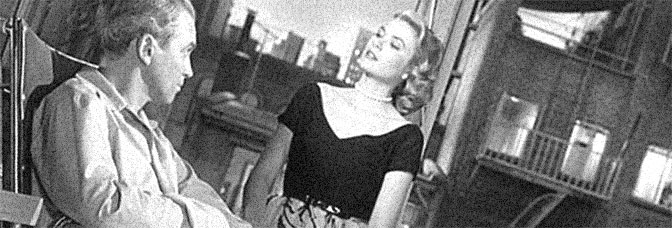Rear Window is an absurdly good time. It’s breathtakingly produced and the set is a marvel on its own, but it’s also an absurdly good time. You’ve got Thelma Ritter chastising James Stewart not just for peeping, she also chastises him for not being serious enough about Grace Kelly. How could it not be an absurdly good time.
So the film is simultaneously Hitchcock the popular filmmaker–enjoy these stars in these performances–it’s Hitchcock the technical filmmaker. The first half of the film, maybe even longer, is usually Hitchcock showing off what he, cinematographer Robert Burks, editor George Tomasini, and uncredited(!) sound editor Howard Beals can do. What they do is transport the viewer into a New York apartment, staring out at the world, with Stewart around to play tour guide for a while. Rear Window isn’t just the story of Stewart healing from a broken leg or deciding whether or not to settle for Grace Kelly or even solving a murder–it’s all the little stories going on around. It’s the care screenwriter John Michael Hayes takes in how Stewart’s interpretation of these stories comes through. It’s delicate and deliberate and just part of that breathtaking production. Rear Window takes itself very seriously. You have to take yourself seriously if you’re going to have Jimmy Stewart complain Grace Kelly is just too perfect for him. You need Thelma Ritter there. With Rear Window, there can be no substitutions. Everything is just so.
After setting up the murder mystery–which brings Wendell Corey into the film and apartment as Stewart’s old war buddy now copper–Rear Window still takes its time. Hitchcock and Hayes play around with the mystery plot line, really changing up the pace of the film. It takes place over less than a week, with the initial nights really emphasized. The repetitive effect, with the occasional car horn and steady rainfall, brings the viewer in. Rear Window enthralls, quite intentionally. The last act is real time, neither the viewer nor the narrative able to handle much more. Hitchcock has a great sense for when he’s going too far, asking too much. He guides it beautifully.
All of the performances are great. Ritter’s hilarious, Kelly’s too perfect, Stewart’s–Stewart. Stewart is immobile, but always active. He’s simultaneously the viewer’s guide and de facto view finder and protagonist. He doesn’t get a lot of protagonist help from Hayes’s script after a while, just because there’s too much going on, but Stewart makes it happen. In fact, he’s almost good enough for it to be believable he’s closer in age to Kelly than he is to Ritter. The chemistry between the actors is just too good. Rear Window’s got a lot of dialogue and it has to be done just right, not only for exposition, but to cultivate that chemistry. Hitchcock knows without it, Rear Window would be too voyeuristic.
Wendell Corey’s a lot of fun too as the straight man. It’s a hard part because everyone wants there to be a crime, everyone wants there to be a mystery. Except Corey. He wants to go home, so the viewer’s inclined against him. Hitchcock and Corey play with that hostility. Because it’s a smart movie.
Rear Window’s all-around awesome.
 ★★★★
★★★★
CREDITS
Directed by Alfred Hitchcock; screenplay by John Michael Hayes, based on a story by Cornell Woolrich; director of photography, Robert Burks; edited by George Tomasini; music by Franz Waxman; released by Paramount Pictures.
Starring James Stewart (L.B. Jefferies), Grace Kelly (Lisa Carol Fremont), Wendell Corey (Det. Lt. Thomas J. Doyle), Thelma Ritter (Stella), and Raymond Burr (Lars Thorwald).
RELATED

Leave a Reply